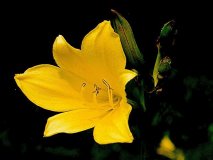Day Lily Root
http://www.100md.com
《e Natural Health Center》
 |
 |
 |
 |
Vegetables
Day Lily Root
Latin:
Hemerocallis lilioasphodelus
Origin:
The root of the plant Hemerocallis lilioasphodelus L. or Hemerocallis flava (L.), of the genus Hemerocallis of the family Lily (Liliaceae). Possibly native to China, it is now distributed from central Europe to eastern Asia.
, 百拇医药
The perennial plant grows to about 0.6 m by 1 m. It is in flower from May to July. The scented flowers are hermaphrodite (have both male and female organs) and are pollinated by insects. The plant is self-fertile. It can grow in semi-shade (light woodland) or no shade. It requires dry or moist soil.
Members of the genus have long-stalked clusters of funnel- or bell-shaped flowers that range in color from yellow to orange and are each short-lived (hence "day" lily). Day lilies also have fleshy roots and narrow, sword-shaped leaves that are grouped at the base of the plant. Leaves can reach 90 cm in length.
, http://www.100md.com
The day lily fruit is a capsule. Some species of Hemerocallis are cultivated as ornamentals or for their edible flowers and buds.
Also called Yellow Day Lily Root, Orange Day Lily Root and Yellow-flower Vegetable Root.
See also Flowers and Tea, Day Lily.
Properties:
Sweet and bitter in flavor, cool in nature, it is related to the spleen and lung channels.
, http://www.100md.com
Functions:
Clears heat and cools the blood, promotes urination, calms the mind, benefits eye-sight, induces milk secretion (nourishes the blood and supplements deficiency), detoxifies.
Day lily root is anti-inflammation, antipyretic (relieves or reduces fever) and analgesic (alleviates pain). Also having diuretic action and relieving deep-colored urine in children.
Applications:
, 百拇医药
For all kinds of mild bleeding.
Use 10 g root of day lily decocted in 100 ml water under slow fire for 15 minutes and serve as one would tea.
Dosage and Administration:
The root is served cooked. It tastes like a blend of sweet corn and salsify. The swollen roots are quite small and are only really worthwhile using if the plant is being dug up for divisions or some other reason.
, 百拇医药
Cautions on Use:
Large quantities of the leaves are said to be halucinogenic. Blanching the leaves, though, could remove this hallucinatory component, as reported in 'Hemerocallis. Day Lilies.' (Batsford. 1992). This comprehensive book on the species does not make clear what it means by blanching. It could be excluding light from the growing shoots or immersing in boiling water.
Reference Materials:
, http://www.100md.com
Toxic or Side Effects:
Modern Researches:
Day lily contains asparagin, colchicine, vitamins A, B and C, protein and anthra-quinone A, B, C, D and F.
The juice of the roots is an effective antidote in cases of arsenic poisoning. The root also has a folk history of use in the treatment of cancer - extracts from the roots have shown anti-tumour activity.
A tea made from the boiled roots is used as a diuretic., 百拇医药